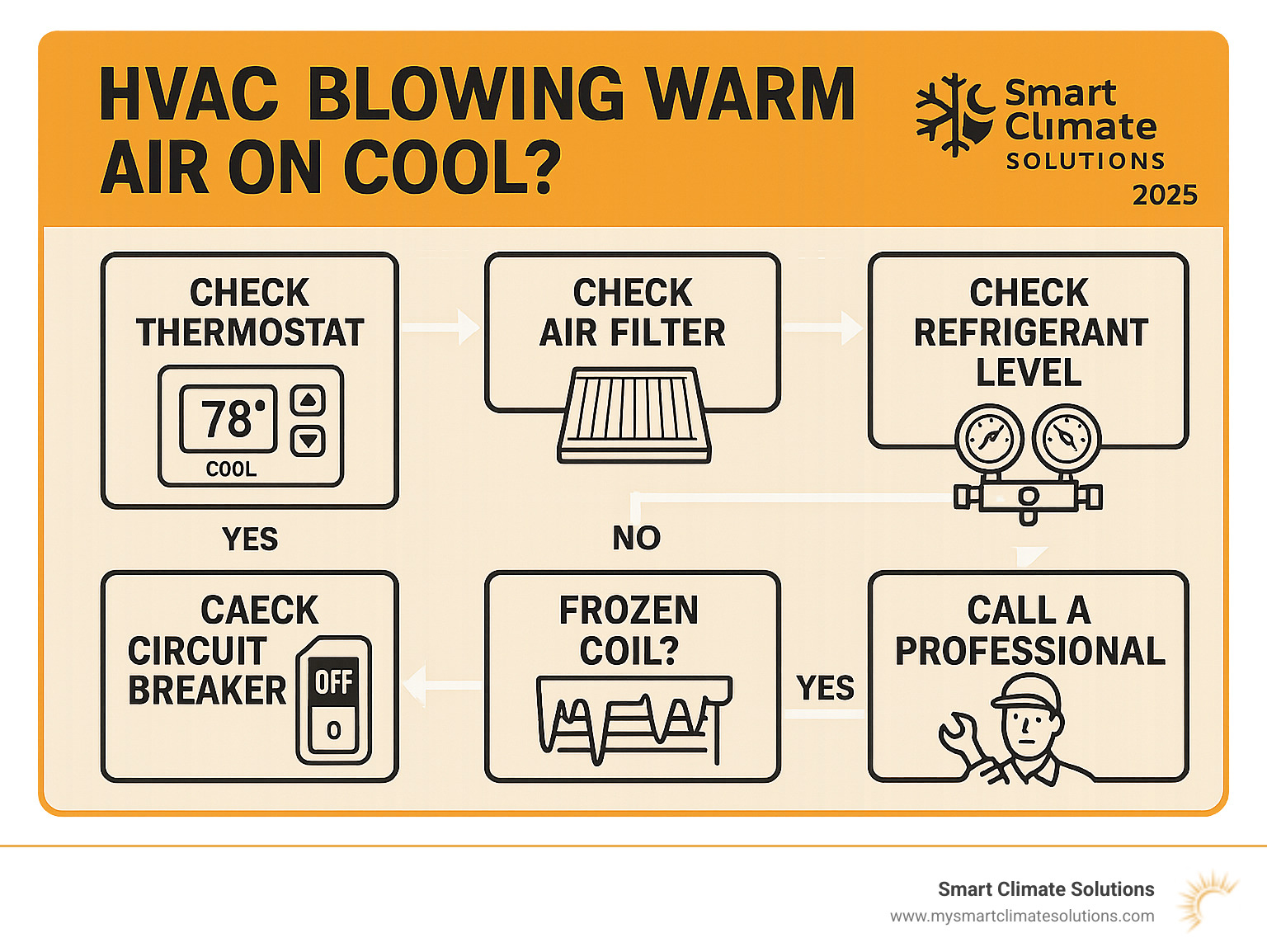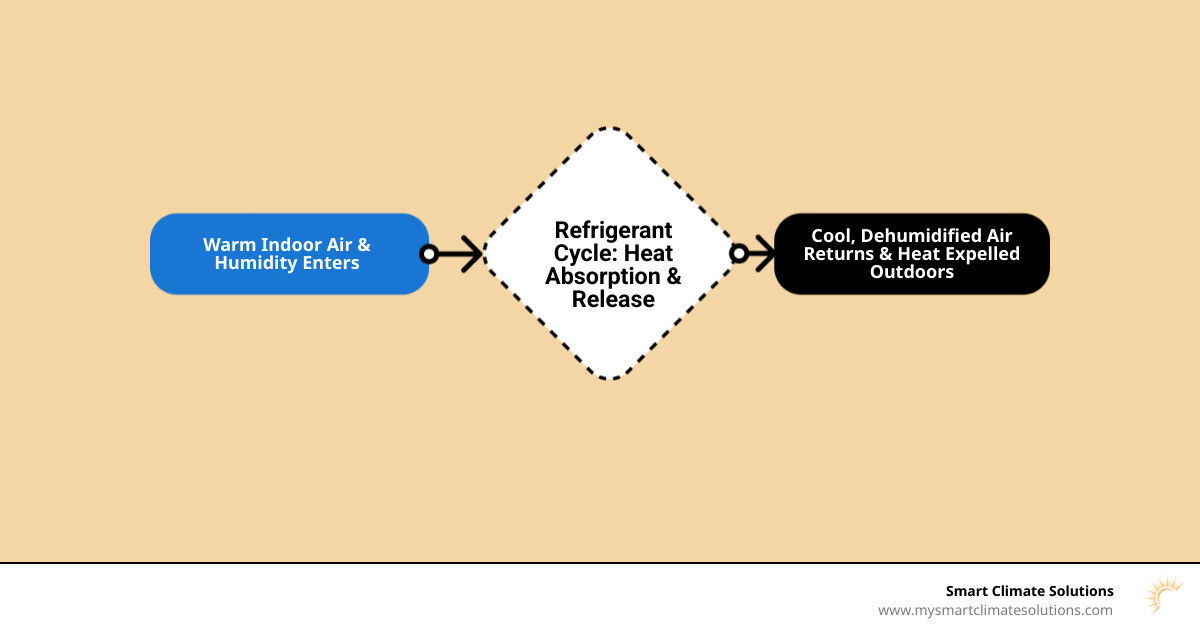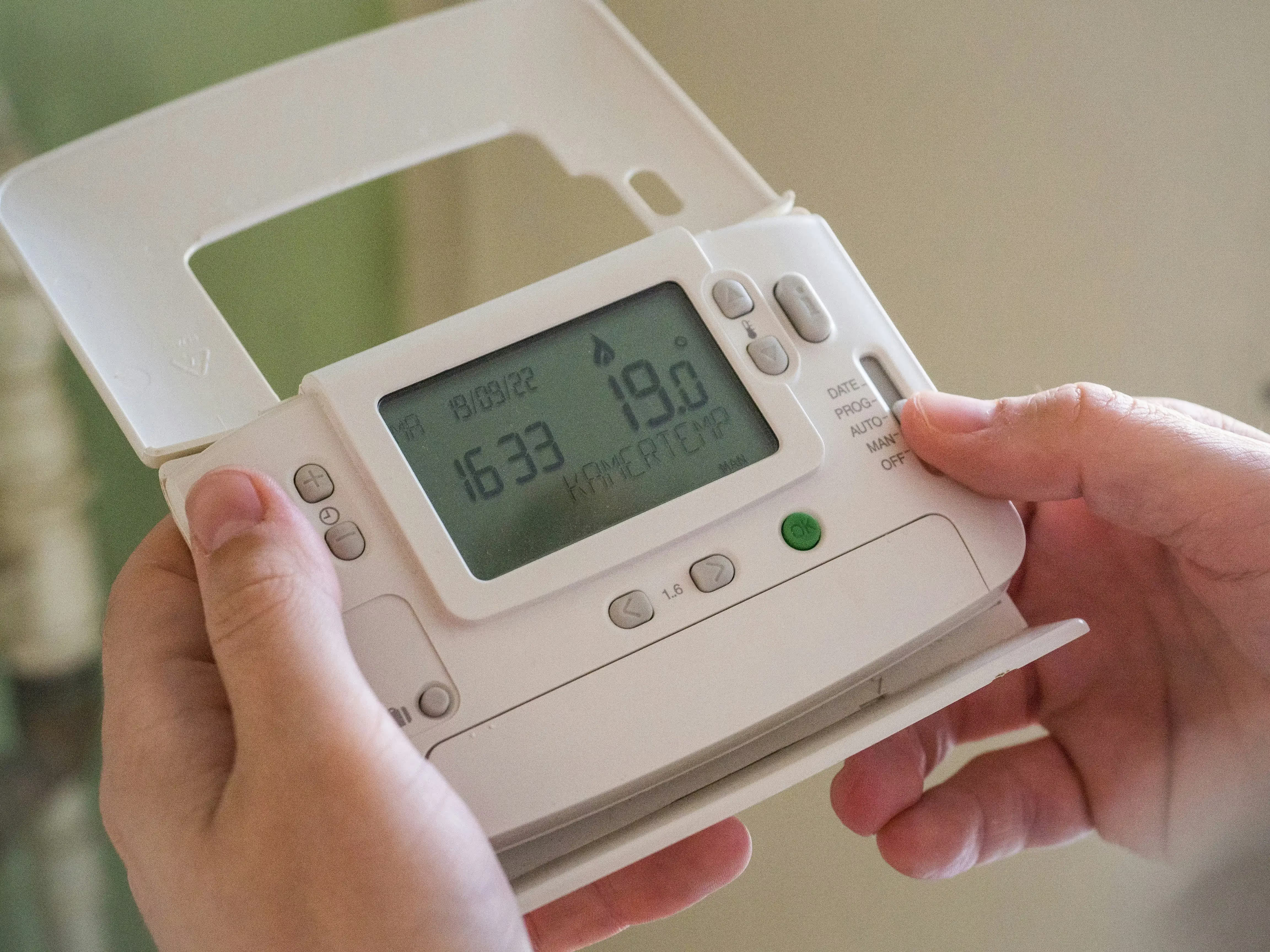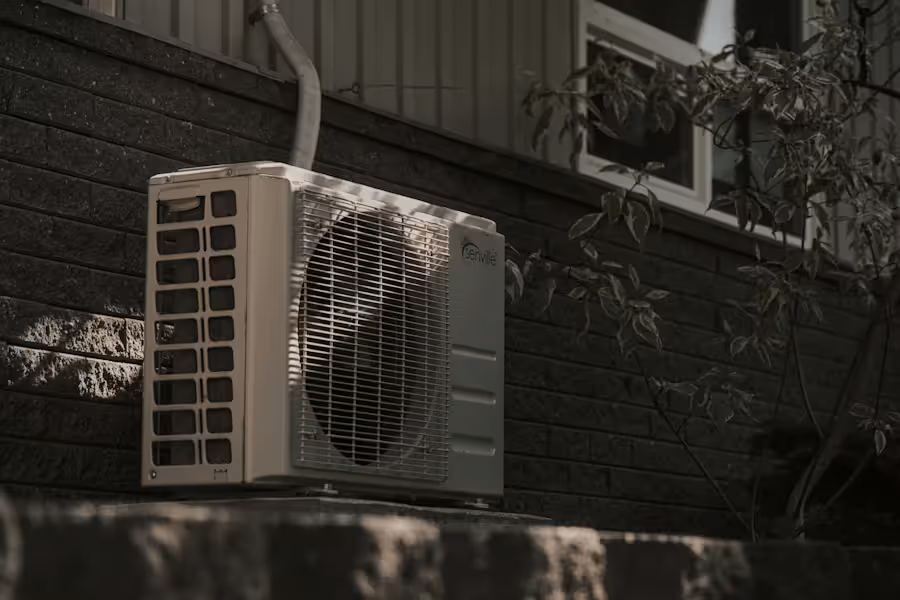When Your HVAC Blowing Warm Air on Cool Becomes a Summer Nightmare
When your hvac blowing warm air on cool settings strikes on a scorching summer day, it's more than just uncomfortable - it's downright maddening. Picture this scenario from our research: "You've been sunbathing in your backyard for an hour, and once the timer finally beeps, you're absolutely sizzling. You scurry across the patio stones, go inside, and close the door behind you. But the house is warm! You walk to a nearby AC supply vent only and feel a jet of warmth."
Quick Fix Checklist for HVAC Blowing Warm Air:
- Check thermostat - Ensure it's set to "Cool" and fan is on "Auto"
- Replace dirty air filter - Clogged filters restrict airflow
- Check circuit breakers - Look for tripped breakers on outdoor unit
- Inspect outdoor unit - Make sure condenser fan is running
- Look for ice - Frozen coils need to thaw before system works
- Call professional - For refrigerant leaks, electrical issues, or compressor problems
The most common reasons for this frustrating problem include incorrect thermostat settings, dirty air filters that restrict airflow, low refrigerant levels due to leaks, frozen evaporator coils, or electrical issues with the outdoor unit. While some fixes are simple DIY tasks, others require professional expertise to diagnose and repair safely.
I'm Bill Scott, general manager of Smart Climate Solutions with over 15 years of HVAC experience helping Pittsburgh homeowners solve hvac blowing warm air on cool problems. In this guide, I'll walk you through the step-by-step troubleshooting process to get your system cooling again, starting with the simplest checks you can do yourself.

Relevant articles related to hvac blowing warm air on cool:
First-Response Troubleshooting: Simple Fixes You Can Do Yourself
When your air conditioner decides to play tricks and starts blowing warm air, it can feel like a crisis. But before you panic or reach for the phone, there are a few simple checks you can perform. These initial troubleshooting steps are often surprisingly effective and can save you time and money. Think of us as your HVAC coaches, guiding you through the first line of defense against the heat. Our goal is to empower you with the knowledge to potentially fix the issue yourself, or at least confidently identify when it's time to call in the pros for AC Repair Pittsburgh.
Check Your Thermostat Settings
This might sound obvious, but we've seen it countless times: a homeowner thinks their AC is broken, only to find the thermostat was set incorrectly. It's a common mistake, especially if someone else in the household adjusted it.
First, ensure your thermostat is set to "Cool" mode. Sometimes, it might accidentally be switched to "Heat" or just "Fan." If it's on "Heat," your system will literally be trying to warm your home, not cool it. This is one of the most common reasons an HVAC system blows warm air in cooling mode.
Next, check the fan setting. It should typically be on "Auto." When the fan is set to "Auto," it only runs when your system is actively cooling your home. If it's set to "On," the fan will continuously blow air, even if the outdoor unit isn't cooling. This means it's just circulating the warm air already in your home, making you think your AC is blowing warm air when it's just the indoor fan doing its job without the cooling component engaged. Setting the fan to "Auto" is recommended for optimal cooling and energy efficiency.
Finally, confirm that the temperature setting on your thermostat is lower than the current room temperature. Your AC won't kick on to cool if it thinks your home is already cool enough. For example, if your home is 78 degrees Fahrenheit, and your thermostat is set to 75 degrees Fahrenheit, it should be running. If it's set to 80 degrees Fahrenheit, it won't.
Inspect the Air Filter
A dirty air filter is like trying to breathe through a pillow - it restricts airflow and makes your HVAC system work much harder than it needs to. This is another incredibly common culprit when your hvac blowing warm air on cool.
How does a dirty air filter cause your HVAC system to blow warm air? When the filter is clogged with dust, dirt, pet dander, and other debris, it significantly restricts the amount of air that can pass through to the evaporator coil. This reduced airflow makes it harder for the AC to cool the air effectively. As a result, the air coming out of your vents won't be as cold, or it might even feel warm. Over time, this can also lead to your evaporator coil freezing, which we'll discuss in more detail shortly.
We recommend checking your air filter monthly, especially during peak cooling season. Most systems require a new filter every one to three months, but if you have pets, allergies, or live in a dusty area, you might need to change it more frequently. This simple task is a cornerstone of good AC Maintenance and can prevent many headaches.
Check the Circuit Breaker
Your HVAC system relies on electricity, and sometimes, a simple tripped circuit breaker can be the reason your AC is blowing warm air. This is especially true if your indoor fan seems to be running, but you don't hear or see the outdoor unit operating.
The outdoor unit (condenser) of your AC system typically has its own dedicated circuit breaker in your home's electrical panel. If this breaker trips, the outdoor unit loses power and stops cooling the air. The interior system, however, might continue to blow air around, mistakenly thinking that it is being cooled by the outside unit. So, while air is moving, it's just room-temperature air.
Go to your electrical panel and look for a breaker labeled "AC," "Furnace," "Condenser," or a similar identifier. If you find a breaker that's in the "off" position or somewhere in the middle (tripped), simply push it firmly to the "off" position, then back to the "on" position. Give your system a few minutes to restart and see if cooling resumes.
If the circuit breaker trips repeatedly after you reset it, do not keep resetting it. This indicates a more serious electrical issue or a problem with your AC unit itself that's drawing too much power. At this point, it's time to call a professional. Our team offers 24 Hour AC Repair services in Pittsburgh, Burgettstown, Washington, and surrounding areas, ready to assist with urgent electrical or AC problems.
Why Your HVAC is Blowing Warm Air on Cool: Common Mechanical Culprits
If those simple checks didn't solve your problem, don't worry - you're not alone. When your hvac blowing warm air on cool persists after the basic troubleshooting, it usually means there's a mechanical issue within the system itself. Think of it like a car that won't start - sometimes it's just an empty gas tank, but other times it's something under the hood.

Here's the thing about air conditioners that might surprise you: they don't actually create cold air. Instead, they're heat movers - they grab the heat from inside your home and dump it outside. This happens through an intricate dance involving refrigerant that changes from liquid to gas and back again, along with components like the compressor, condenser, evaporator, and various fans working together. When any part of this team stops doing its job, the heat transfer process breaks down, and you're left wondering why warm air is coming from your vents. For those curious about the technical details, you can explore how an AC system works.
Low Refrigerant: The Reason Your HVAC is Blowing Warm Air on Cool
Think of refrigerant as the blood flowing through your AC system's veins. Without enough of it, your system simply can't absorb the heat and humidity from your home's air. Here's what makes this tricky: refrigerant isn't something that gets used up like gasoline in your car. If your system is low on refrigerant, it means you have a leak somewhere.
The telltale signs are pretty clear once you know what to look for. The most obvious one is warm air coming from your vents - your system just can't grab enough heat without adequate refrigerant levels. You might also hear hissing or bubbling sounds coming from your indoor unit, which is the refrigerant escaping or struggling to flow properly. Some homeowners notice their energy bills creeping up because the system runs longer trying to cool the house.
Low refrigerant can also cause your evaporator coil to freeze up, which we'll talk about next. When there's not enough refrigerant flowing through the system, the coil gets too cold and ice starts forming.
Here's something we can't stress enough: refrigerant leaks require professional attention. We've seen too many homeowners try the "quick fix" of just adding more refrigerant without addressing the leak. That's like putting a band-aid on a burst pipe - it might work temporarily, but you're just throwing money away and potentially damaging your system further. Our certified technicians know how to find the leak, fix it properly, and restore your system to peak performance. Understanding AC Compressor Repair Cost can help you prepare if the leak has caused additional damage.
Frozen Evaporator Coils
Picture trying to cool your home when the part that's supposed to get cold is actually covered in a thick layer of ice. That's exactly what happens with frozen evaporator coils, and it's a surprisingly common reason for hvac blowing warm air on cool.
The evaporator coil sits inside your home, usually in the indoor unit or air handler. This is where the magic happens - where refrigerant absorbs heat from your home's air. When ice forms on this coil, it acts like a thick winter coat, preventing the coil from doing its job. Your fan keeps blowing air, but that air can't get cold because it can't make proper contact with the refrigerant-filled coil underneath all that ice.
Two main culprits cause this freezing problem. Poor airflow is the most common - usually from that dirty air filter we talked about earlier, but sometimes from blocked return vents or even damaged ductwork. When not enough warm air flows over the coil, it gets too cold and freezes. The other cause is low refrigerant, which makes the coil temperature drop too low.
If you find a frozen coil, here's your action plan: Turn off your AC immediately - switch the thermostat to "Off" or "Fan Only" if available. Turn on just the fan to help circulate air and speed up thawing. Be patient - complete thawing takes several hours, and you'll want towels around the unit to catch dripping water. address the root cause by changing your filter and checking for blocked vents. If the problem returns, it's time to call us for help with AC Not Cooling issues.
Dirty Condenser Coils
While your evaporator coil works inside, the condenser coil is the hardworking component in your outdoor unit. Its job is to release all that heat your system pulled from inside your home. When this coil gets caked with dirt, leaves, grass clippings, or other outdoor debris, it's like trying to cool off while wearing a heavy winter jacket.
The outdoor unit takes a beating from the elements. Pollen in spring, dust storms in summer, falling leaves in autumn - it all builds up on those condenser coils. When the coils can't release heat effectively, refrigerant pressure rises, the system works much harder, and cooling efficiency drops dramatically. You'll feel this as warm air from your vents, and your poor compressor might eventually overheat from the extra strain.
The good news is this one has a relatively simple fix. Keep at least two feet of clear space around your outdoor unit - trim back bushes, remove debris, and don't use the area for storage. You can gently hose down the coils yourself (after turning off power at the disconnect switch), but for a thorough cleaning and inspection, professional Air Conditioner Maintenance is your best bet.
A Faulty Compressor or Condenser Fan: The Problem with Your HVAC Blowing Warm Air on Cool
These two components are the powerhouse duo of your outdoor unit. When either one fails, your hvac blowing warm air on cool is almost guaranteed, and unfortunately, these aren't DIY fixes.
The compressor is essentially the heart of your AC system. It compresses refrigerant gas, increases its pressure and temperature, and keeps it circulating through the entire system. Without a working compressor, the whole cooling cycle stops dead in its tracks. You might hear the outdoor unit making a humming or buzzing sound without actually running, or it might not make any noise at all.
The condenser fan sits on top of your outdoor unit, pulling air across those condenser coils to help release heat. When this fan stops working, all that heat your system absorbed from inside has nowhere to go. The system quickly overheats and shuts down as a safety measure. You'll typically hear the compressor trying to run, but notice no air movement from the top of the outdoor unit.
Both scenarios require immediate professional attention. These are complex, expensive components that need proper diagnosis and expert repair or replacement. If your outdoor unit isn't running, the fan isn't spinning, and you've already checked the circuit breaker, it's time to call in the cavalry. We offer 24 Hour Emergency HVAC services throughout Pittsburgh, Washington, Steubenville, and surrounding areas for exactly these kinds of critical breakdowns.
Special Case: Why Your Heat Pump Blows Warm Air in Summer
If you have a heat pump instead of a traditional air conditioner, you might be dealing with a unique situation when your hvac blowing warm air on cool. Heat pumps are fascinating systems that work double duty - they can both heat and cool your home by literally reversing the flow of refrigerant. Think of it as a two-way street for heat transfer.
During summer, your heat pump should be absorbing heat from inside your home and moving it outside, just like a regular AC. But here's where things can go wrong: the component responsible for this direction switching, called the reversing valve, can sometimes get stuck or malfunction.
When the reversing valve gets stuck in heating mode during summer, it's like your system has forgotten what season it is. Even though your thermostat is calling for cooling, your heat pump is actually trying to warm your home. This creates the frustrating scenario where your outdoor unit is running, you can hear the system working, but warm or even hot air is coming from your vents.
You might hear a clicking noise when the system tries to switch modes, or the clicking might be completely absent if the valve is completely stuck. Sometimes homeowners notice that their heat pump seems to get confused about which mode it should be in, especially during those transitional spring and fall months.
The reversing valve can fail for several reasons. Sometimes it's a mechanical issue where the valve itself gets stuck due to debris or wear. Other times, it's an electrical problem with the switching mechanism that tells the valve when to change positions. Occasionally, issues with the defrost mode can also interfere with proper valve operation, though this is more common in winter heating scenarios.
Unfortunately, diagnosing and repairing a faulty reversing valve isn't a DIY project. It requires specialized knowledge of heat pump systems and the right tools to safely handle refrigerant lines and electrical components. Our team at Smart Climate Solutions has extensive experience with all types of Residential Heating and Cooling Options, including the unique challenges that heat pumps can present.
If you suspect your heat pump's reversing valve is the culprit behind your cooling troubles, don't hesitate to give us a call. We understand these systems inside and out and can quickly determine whether you're dealing with a valve issue or another problem entirely.
Keeping Your Cool: Preventative Maintenance and When to Call a Pro
We get it - when your hvac blowing warm air on cool is making your home feel like an oven, the DIY spirit kicks in hard. After twenty years in this business, I've seen plenty of homeowners successfully tackle the basic troubleshooting steps we've covered. There's real satisfaction in fixing your own AC problem with a simple filter change or thermostat adjustment.
But here's the thing - sometimes your air conditioner needs more help than a weekend warrior can provide. Knowing when to roll up your sleeves and when to call the cavalry can save you money, prevent further damage, and keep you from turning a manageable repair into a major headache.
Our certified technicians have the specialized tools and expertise to handle complex electrical issues, refrigerant problems, and major component replacements safely. More importantly, we understand that your comfort can't wait - that's why we offer comprehensive HVAC Preventive Maintenance Plans to prevent problems before they start.
Preventative Maintenance Checklist
The absolute best way to avoid your hvac blowing warm air on cool is to stay ahead of problems with regular maintenance. Think of it like brushing your teeth - a little consistent effort prevents big, expensive problems down the road.
Change filters regularly - this is your most powerful weapon against AC problems. We've harped on this throughout our guide because a clean filter prevents so many issues. Check it monthly during peak season and replace every one to three months, or more often if you have pets or allergies.
Clean coils annually - while you can gently rinse your outdoor condenser coil with a garden hose (power off first!), both your indoor and outdoor coils benefit from professional cleaning. Clean coils transfer heat efficiently, which means better cooling and lower energy bills.
Check drain lines regularly because your AC removes humidity from the air, creating condensate water that needs somewhere to go. When drain lines get clogged with algae or debris, water backs up and triggers safety switches that shut down your cooling. A simple maintenance check can prevent this frustrating problem.
Keep your outdoor unit clear of leaves, grass clippings, and debris. Your condenser needs at least two feet of breathing room in all directions. We've seen units completely choked by overgrown vegetation - not a pretty sight.
Schedule professional tune-ups each spring before the heat hits. During these visits, our technicians clean components you can't reach, check refrigerant levels, test electrical connections, and catch small problems before they become expensive repairs. Many homeowners wonder Are HVAC Maintenance Plans Worth It - in our experience, the peace of mind and cost savings make them a smart investment.
When to Call for Professional HVAC Repair
We love empowering homeowners with knowledge, but some situations require professional expertise. Here's when to set down the tools and pick up the phone.
DIY steps failed - you've checked your thermostat settings, replaced the air filter, and verified your circuit breaker, but your system is still blowing warm air. At this point, you've eliminated the common culprits and likely need professional diagnosis.
Circuit breaker trips repeatedly - if your breaker keeps tripping after you reset it, stop resetting it immediately. This signals a serious electrical issue or a failing component like a compressor drawing too much power. Continuing to reset a tripping breaker can cause dangerous conditions and expensive damage.
Ice returns after thawing - you found frozen coils, thawed them properly, but they're freezing up again. This persistent freezing usually indicates a refrigerant leak or ongoing airflow problem that needs professional attention.
You suspect a refrigerant leak - those hissing or bubbling sounds we mentioned, combined with poor cooling, often mean refrigerant is escaping. Only certified technicians can legally and safely handle refrigerant repairs. DIY refrigerant work is illegal in most areas and potentially dangerous.
Loud or unusual noises coming from your system demand immediate attention. Grinding, squealing, banging, or persistent humming sounds often indicate failing motors, compressor problems, or other mechanical issues that can cause catastrophic damage if ignored.
Burning smells are never normal and require immediate action. Turn off your system right away and call for emergency service. Electrical problems and overheating components create fire hazards that need professional diagnosis.
When any of these warning signs appear, our team provides fast, reliable HVAC Repair Pittsburgh service throughout our coverage areas. We understand that comfort emergencies don't follow business hours - that's why we're here when you need us most.
Conclusion
Dealing with your hvac blowing warm air on cool can be incredibly frustrating, especially when you're counting on your AC for relief from the summer heat. But here's the good news: you're now armed with the knowledge to tackle this problem head-on, and that's empowering.
Remember to start with the basics - they're called "basics" for a reason. Check your thermostat settings to make sure it's actually set to cool and not accidentally switched to heat or fan-only mode. Replace that air filter if it looks like it's seen better days (and trust us, a dirty filter is often the sneaky culprit behind cooling problems). Check your circuit breaker because sometimes the fix is as simple as flipping a switch back on.
These simple troubleshooting steps resolve more cooling issues than you might expect, and they can save you both time and money. It feels pretty great to fix your own AC, doesn't it?
However, when the problem runs deeper - like refrigerant leaks that cause persistent warm air, frozen coils that keep refreezing, or unusual noises that sound like your system is trying to communicate in some sort of mechanical morse code - that's when it's time to call in the cavalry. Some problems require the expertise, tools, and certifications that only professional technicians possess.
Regular preventative maintenance is truly your best defense against future hvac blowing warm air on cool scenarios. Think of it as giving your AC system the care it needs to take care of you. Changing filters regularly, keeping the outdoor unit clear, and scheduling annual professional tune-ups can prevent most cooling emergencies before they start. It's much easier to maintain a healthy system than to repair a broken one.
At Smart Climate Solutions, we've been helping Pittsburgh area homeowners stay comfortable for over 15 years. Our certified technicians understand how frustrating it is when your AC decides to take a vacation during a heat wave. That's why we offer 24/7 emergency support - because cooling problems don't wait for business hours, and neither do we.
Whether you need a quick repair, a thorough maintenance check, or just some friendly advice about your HVAC system, we're here to help. When your AC turns up the heat instead of keeping things cool, we're the team that knows how to set things right.
Contact us for expert HVAC service and repair today, and let's get your home back to the comfortable haven it should be.









.png)
